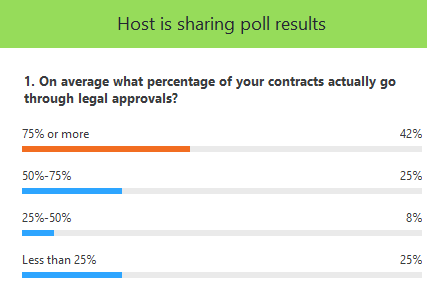What Contract Metrics Can Say About Your Organization
There was a time not that long ago when contracts where simply an instrument of agreement between two or more parties and lived happily in a shared folder without any visibility; but that is no longer the case today. Contracts sit at the heart of business. They essentially memorialize the financial agreements that exist between parties and contain some of the most mission-critical information for companies. And that means that they can tell us a ton about the health and success of an organization. But what else can you learn from or track in your contracts? What KPIs should you be paying attention to in order to get the most out of your contracts, and, when you’re not measuring up, what can you do to turn things around?
We moderated a panel discussion with contracting experts Ewa Hugh from SurveyMonkey and Ronak Ray of Pantheon during LegalWeek(year) and here is what they said:
Impacts On Cycle Times
It’s already been well established that poor contract management costs businesses an average of 9% of revenue annually. Since contracts contain a wealth of financial information about companies, it’s also true that the process of contract creation, as well as its post-signature performance, contains even further strategic information if you know what to look for. Since cycle times are an issue that many companies face, we asked the audience to share how long a business agreement takes them from request to signature.

While the plurality of the participants said that their contracts take over a month to complete, Ronak pointed out that different contract types and industries can have wildly different cycle times.
As one example, he explained that, thanks to the contract insights found in Malbek, he was able to see that his Account Executives selling to educational institutions weren’t actually slow. They were just dealing with an industry that took longer to finalize contracts than other industries. This insight allowed him to know what to expect and adapt the way his company approached this aspect of their business.
With metrics as the guide, legal and technology became an accelerator for the business. Knowing that different industries have different average cycle times helped his company see huge reductions in cycle time. Quarter over quarter improvements were as high as 39%. Having true visibility into what is going on and where your contract is lets you understand where things are getting snagged up and where to focus your optimization efforts.
Impacts on Growth
Growth is good, but can your team scale to support it? Much like a houseplant that has outgrown its pot, a business’s growth can become “rootbound” by poor contract management with no capacity for growth. Contract automation can let your team scale contract volume capacity by 5 to 10 times. And contract metrics can tell you what volume you can support now and in the future.
Ronak explained that contract metrics allow you to take incremental steps, test how much you’ve grown, and give you time to react to it. This allows you to test the waters before jumping in and helps you to understand what your business limits are now and how you can proactively be ready for increased volume and growth. Making small changes and measuring each step of the way keeps you from guessing.
Contract metrics also give you a tangible benchmark that helps to justify a CLM solution’s cost. Based on data, you can demonstrate to your stakeholders the benefits of your CLM solution (such as increased efficiency or increased growth) and show the value you have achieved.
Impacts on the Contract Approval Process
Often the assumptions about why a contract’s cycle time is so long are anecdotal, and frequently blame is placed on legal. However, until you actually have metrics, the assumptions are hard to dispel or fix.
Regardless of whether legal is actually the hold-up in contract cycle times, there are certainly efficiencies to be gained by removing legal from aspects of the contract approval process. While the thought of that may make some legal professionals queasy, we asked the audience how involved their legal department is in approvals.

Ewa pointed out that an effective CLM solution empowers business users to not rely on legal as much. When users understand what they can and cannot do within the system, they have the guidance and confidence to negotiate certain types of contracts themselves. And self-service contracts can make all the difference to getting deals done faster. At Malbek, we’ve seen our customers realize significant contracting process efficiencies by reducing the amount of involvement legal has in approvals by as much as 80-90%.
Whether you are facing long contract cycle times, a legal team that is being asked to process more contracts without more headcount, or a tortured approval process, a modern CLM solution can help you diagnose and ultimately fix these challenges.






